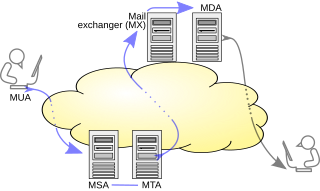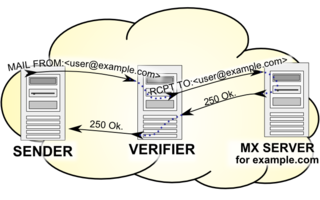Related Research Articles
The Domain Name System (DNS) is a hierarchical and distributed naming system for computers, services, and other resources in the Internet or other Internet Protocol (IP) networks. It associates various information with domain names assigned to each of the associated entities. Most prominently, it translates readily memorized domain names to the numerical IP addresses needed for locating and identifying computer services and devices with the underlying network protocols. The Domain Name System has been an essential component of the functionality of the Internet since 1985.

Electronic mail is a method of transmitting and receiving messages using electronic devices. It was conceived in the late–20th century as the digital version of, or counterpart to, mail. Email is a ubiquitous and very widely used communication medium; in current use, an email address is often treated as a basic and necessary part of many processes in business, commerce, government, education, entertainment, and other spheres of daily life in most countries.
The Simple Mail Transfer Protocol (SMTP) is an Internet standard communication protocol for electronic mail transmission. Mail servers and other message transfer agents use SMTP to send and receive mail messages. User-level email clients typically use SMTP only for sending messages to a mail server for relaying, and typically submit outgoing email to the mail server on port 587 or 465 per RFC 8314. For retrieving messages, IMAP is standard, but proprietary servers also often implement proprietary protocols, e.g., Exchange ActiveSync.
An email address identifies an email box to which messages are delivered. While early messaging systems used a variety of formats for addressing, today, email addresses follow a set of specific rules originally standardized by the Internet Engineering Task Force (IETF) in the 1980s, and updated by RFC 5322 and 6854. The term email address in this article refers to just the addr-spec in Section 3.4 of RFC 5322. The RFC defines address more broadly as either a mailbox or group. A mailbox value can be either a name-addr, which contains a display-name and addr-spec, or the more common addr-spec alone.
Various anti-spam techniques are used to prevent email spam.
A Service record is a specification of data in the Domain Name System defining the location, i.e., the hostname and port number, of servers for specified services. It is defined in RFC 2782, and its type code is 33. Some Internet protocols such as the Session Initiation Protocol (SIP) and the Extensible Messaging and Presence Protocol (XMPP) often require SRV support by network elements.
Sender Policy Framework (SPF) is an email authentication method which ensures the sending mail server is authorized to originate mail from the email sender's domain. This authentication only applies to the email sender listed in the "envelope from" field during the initial SMTP connection. If the email is bounced, a message is sent to this address, and for downstream transmission it typically appears in the "Return-Path" header. To authenticate the email address which is actually visible to recipients on the "From:" line, other technologies such as DMARC must be used. Forgery of this address is known as email spoofing, and is often used in phishing and email spam.
A Canonical Name (CNAME) record is a type of resource record in the Domain Name System (DNS) that maps one domain name to another.
Greylisting is a method of defending e-mail users against spam. A mail transfer agent (MTA) using greylisting will "temporarily reject" any email from a sender it does not recognize. If the mail is legitimate, the originating server will try again after a delay, and if sufficient time has elapsed, the email will be accepted.
A bounce message or just "bounce" is an automated message from an email system, informing the sender of a previous message that the message has not been delivered. The original message is said to have "bounced".
Email authentication, or validation, is a collection of techniques aimed at providing verifiable information about the origin of email messages by validating the domain ownership of any message transfer agents (MTA) who participated in transferring and possibly modifying a message.

A message submission agent (MSA), or mail submission agent, is a computer program or software agent that receives electronic mail messages from a mail user agent (MUA) and cooperates with a mail transfer agent (MTA) for delivery of the mail. It uses ESMTP, a variant of the Simple Mail Transfer Protocol (SMTP), as specified in RFC 6409.
Forward-confirmed reverse DNS (FCrDNS), also known as full-circle reverse DNS, double-reverse DNS, or iprev, is a networking parameter configuration in which a given IP address has both forward (name-to-address) and reverse (address-to-name) Domain Name System (DNS) entries that match each other. This is the standard configuration expected by the Internet standards supporting many DNS-reliant protocols. David Barr published an opinion in RFC 1912 (Informational) recommending it as best practice for DNS administrators, but there are no formal requirements for it codified within the DNS standard itself.
The Sender Rewriting Scheme (SRS) is a scheme for bypassing the Sender Policy Framework's (SPF) methods of preventing forged sender addresses. Forging a sender address is also known as email spoofing.
A Domain Name System (DNS) zone file is a text file that describes a DNS zone. A DNS zone is a subset, often a single domain, of the hierarchical domain name structure of the DNS. The zone file contains mappings between domain names and IP addresses and other resources, organized in the form of text representations of resource records (RR). A zone file may be either a DNS master file, authoritatively describing a zone, or it may be used to list the contents of a DNS cache.
Nolisting is the name given to a technique to defend electronic mail domain names against e-mail spam.

Callback verification, also known as callout verification or Sender Address Verification, is a technique used by SMTP software in order to validate e-mail addresses. The most common target of verification is the sender address from the message envelope. It is mostly used as an anti-spam measure.
Email forwarding generically refers to the operation of re-sending a previously delivered email to an email address to one or more different email addresses.
International email arises from the combined provision of internationalized domain names (IDN) and email address internationalization (EAI). The result is email that contains international characters, encoded as UTF-8, in the email header and in supporting mail transfer protocols. The most significant aspect of this is the allowance of email addresses in most of the world's writing systems, at both interface and transport levels.
Backscatter is incorrectly automated bounce messages sent by mail servers, typically as a side effect of incoming spam.
References
- ↑ In these examples, the domain name concerned is in the first column, the TTL (time-to-live) in the second, and the third is the "record Class" (in this case IN for Internet) - then MX to identify the type of record. The TTL is a validity period, indicating when the information must be refreshed from an authoritative name server.
- ↑ RFC 2181, Section 10.3, Clarifications to the DNS Specification, R. Elz, R. Bush (July 1997)
- 1 2 HOWTO - Configure Round Robin and Load Balancing, Page modified: February 28 2014., zytrax.com
- 1 2 3 4 RFC 5321
- 1 2 RFC 974
- ↑ RFC 1035 section 3.3.9
- ↑ If the primary MX responds, but fails mid-transaction, Postfix 1.2 and 2.0 will not try a backup MX. Archived 2009-06-23 at the Wayback Machine , Re: does not change to mx with lower priority, From: Victor Duchovni (Victor.DuchovniMorganStanley.com) Date: Fri Nov 11 2005
- ↑ A greeting failure is an error-code that is sent instead of or in response to the standard SMTP greeting handshake.
- ↑ Craig Partridge (January 1986). MAIL ROUTING AND THE DOMAIN SYSTEM. IETF. doi: 10.17487/RFC0974 . RFC 974 . Retrieved 18 November 2011.
For each MX, a WKS query should be issued to see if the domain name listed actually supports the mail service desired. MX RRs which list domain names which do not support the service should be discarded. This step is optional, but strongly encouraged.
- ↑ This section is adapted from John Levine ietf-smtp message Archived 2008-06-01 at the Wayback Machine